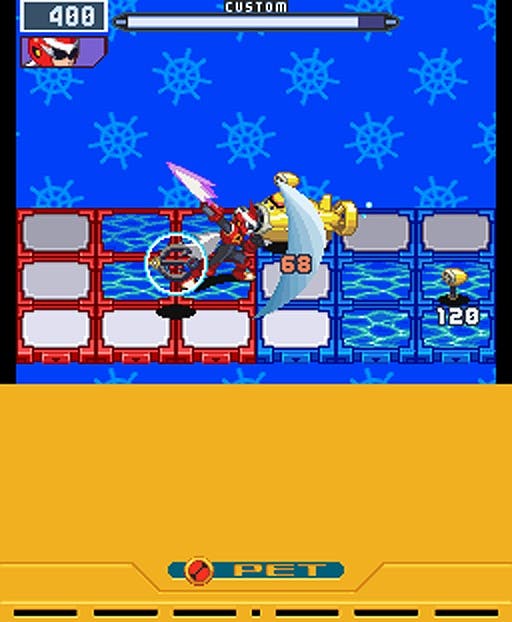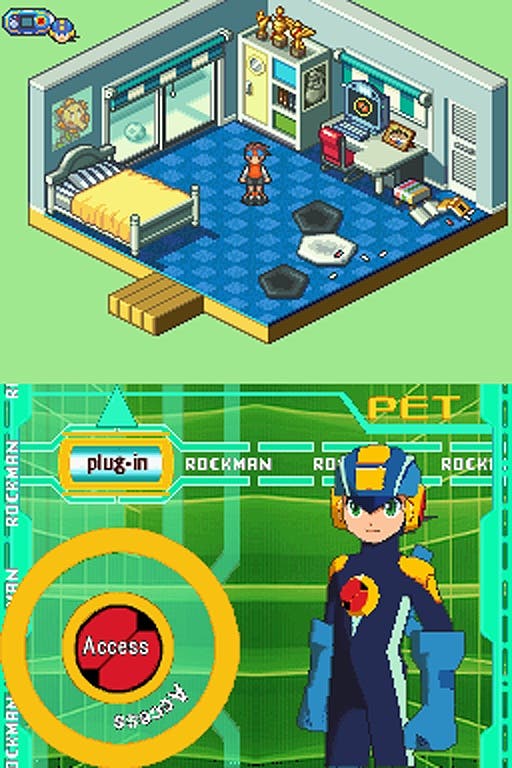Mega Man Battle Network 5: Double Team
Feeling blue.
You used to know where you were with Mega Man.
He was the short, mechanised child of Astro Boy that Capcom kidnapped and dipped in a vat of mercury blue pixel paint. His games were always slightly ropey scrolling platform shooters constantly broken by the fact their protagonist never managed to evolve that most critical move in the platform hero’s repertoire: the duck.
Mega Man games have always looked great (courtesy of one of the most iconic videogame character designs of the last twenty years) but left a slightly bitter, aftertaste. You’ve probably played two Mega Man games in your life: the first because the artwork and animation seduced you and, gee, if he has this many children, Mega Man must be doing something stimulating. The second you played because you wondered if the gameplay might have gotten significantly better this time.
When it didn’t you left it there. And so repeats the generational cycle of people that buy Mega Man games; a perennial conveyer belt of young consumers wooed by its striking silhouette and vibrant colours then put off by the crusty, smelly underbelly you only get to see once you’ve jumped into bed together.
Battle Network is different though. One of the franchise’s countless offshoots designed to woo new punters with a change of wig and frock, these are isometric action-RPGs closer to Pokemon’s card-collecting dynamic than the more traditional get-up of series’ deviations Mega Man X, Mega Man Legends and Mega Man Zero.

So, with all the iterations flying around, perhaps Capcom thought no one would notice that Mega Man Battle Network 5 on the DS is actually the SAME GAME THAT CAME OUT ON THE GBA A FEW MONTHS AGO.
TWICE.
This is the third outing for Battle Network 5 encompassing the two prior GBA versions on the same cart albeit now offering touch-screen and voice activation support. Still, as you will probably have already played and forgotten your Two-Mega Man-Game-Only quotient long before this, we’ll pretend for a moment that you know nothing about the BN series - which you probably literally don’t.
We’re not ten years old anymore but that’s not why Mega Man Battle Network 5 makes us feel so elderly. It’s not even because LAN, the main character, is a little boy with too-cool-for-school geek chic kid friends and a flashy mobile phone that connects to the Internet. It’s actually because all the technological words in the game don’t quite seem to be in the right places. Let’s see: Set in a nondescript American-esque suburb your character “LAN” and his friends all own “PETS” (mobile phones) which contain “NAVIS” (characters) and can be “JACKED” (logged) into to get onto the “INTERNET” (cyberdungeons). Once there, they can control Navi (in LAN’s case Mega Man) to battle “VIRUSES” (enemies) using “CHIPS” (battle cards) that require a certain amount of “MB” (mb) to work.
As you can see it’s a bit like an awkwardly unsure educational episode of Sesame Street from the 1970s where the producers got hold of a computer book from the future, read it and then tried to explain it to kids via puppetry. It’s like all the words to do with computers were picked up and thrown high into the air. Then wherever they fell, be it on characters, cards, systems or environments, that’s where they stayed. If you know anything about computers, which of course you do, it’s utterly confusing being asked to Jack into a Network to shoot a virus before meeting up with a program to retrieve a specRec (special recipe) for your mum.

Still, while this vocabulary rape is perverse, it doesn’t arrest your enjoyment of the game once you get you head around the basics: there’s a real world and a cyberspace world existing as two separate dimensions, in one of which you control LAN and the other Mega Man and things you do in one affect things that happen in the other.
Outside of battles this is a simple action-RPG albeit one furnished with pulsing futuristic floors, ocean-wide plasma screens and Internet access on every street corner. But behind the vaguely interesting setting there are the usual simplistic fetch and retrieve tasks and one-dimensional repetitive conversations to be had. Inside of battles things are far more motivating. Unlike usual RPG convention, fights play out in real time on a 6-by-3 grid that's split evenly into player and enemy areas.
Mega Man's main attacks are randomly decided by drawing tiny chips, each representing a different offensive or defensive technique, from a deck of 30 a la the brilliant Card Fighters Clash. Five chips are selected at the beginning of each battle, and when they're used, others are drawn to take their places. Using chips with the same name or letter designation can chain multiple attacks together and you can also combine some chips to make more powerful attacks. You Gotta Catch ‘em All and unquestionably most of the game’s fun comes from collecting, organising, and storing chips to make the best possible deck from the 300 available ones in the game.
The similarities between BN5 and the Pokemon franchise don’t end there. Similar to how the Ruby and Sapphire versions of those games introduced multiple Pokemon battles to the series, BN5 introduces the ability to alternate between multiple Navis (in addition to Mega Man) during fights. In the main battles you can control two Navis other than Mega man and during the “Liberation Missions” you can control as many as six.

If you have played earlier Battle Network games then BN5 makes a number of key improvements. Many of the cyberdungeons include puzzles and extras (albeit gentle ones) instead of being a simple grind to get through random battles and out the exit door. Dark chips, powerful attack cards that cause Mega Man to lose HP or turn him evil if he uses them too much, are easier to find now, and there are twice as many as were to be found in the last game. They can also be inserted into your deck manually now whereas in the past the CPU would just insert one randomly during a battle. This full control is welcome and allows some gentle player choice over the game’s progression.
The DS specific functions are rudimentary but helpful nonetheless. The GBA-style game plays out on the top screen with the bottom screen always on for menus and, most helpfully, maps when exploring the dungeons. The microphone can be used to cheer Mega Man on in fights but, as with most previous DS games, you probably won’t use it. When organising your chip folder you can drag and drop your chips to where you want them and, er, the polygon animated Mega Man that sits there the rest of the time is quite pretty... Otherwise there’s little that the DS is doing outside of wireless multiplay that the GBA couldn’t or didn’t.
The game’s strengths and weaknesses are indicative of the wider problems with the entire brand. Too many tiny, insignificant, largely inconsequential improvements with each new update have devalued the Mega Man name. Why would you want to pay another £35 for the same game every three months just to witness it becomes slightly more like the game it should have been in the first place? An inch further to the left and this game is a money-grabbing cash-in; there are just enough features to make it a plausible release but really, it’s not good enough.
Tiny incremental tweaks to the function are all very well if your base material is simply amazing or the form changes significantly but, all told, this is an old, whiffy average GBA kids RPG, dull and tired through inbreeding. The main difference now is that you can poke it as it lies there with a stick instead of a finger.

